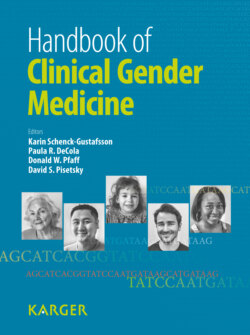Читать книгу Handbook of Clinical Gender Medicine - Группа авторов - Страница 20
На сайте Литреса книга снята с продажи.
Aging
ОглавлениеHealthy aging is a shared goal between sexes and across the gender continuum, yet as the numbers of aging people grow, our knowledge on the topic does not keep pace and our health systems remain largely focused on curative rather than preventive care.
Interestingly, in some high-income countries the higher rates of morbidity in women compared to men are either somewhat diminished or absent as women age [1]. In contrast, a study within India demonstrated that women over the age of 60 continue to report a higher prevalence of disabilities, worse self-rated health, and marginally lower chronic conditions compared to same-aged men [3]. However, when controlled for a number of socioeconomic conditions, the study shows that financially empowered women have equal or better health than similarly aged men [3]. Another study conducted in Africa and Asia shows conflicting information in that women have significantly worse self-reported health than do men even when differences in demographic and socioeconomic factors are adjusted for [16]. These last findings are of particular interest since the majority of women 60 years of age or older reside in low-and middle-income countries and the overall proportion of older people within these countries is rising [11].
In light of LGBT populations’ tendency toward having delayed, avoided, or been the recipient of mismanaged care over their lifespan, they are at a greater risk for increased health issues as they age. They are also disadvantaged by the lack of targeted governmental services available and the potential lack of social networks established to help provide them assistance in navigating healthcare systems as they age [7, 8]. Older LGBT people may also have significant concerns about the need for institutional support in residential facilities for the aged due to inherent social prejudices [7].
